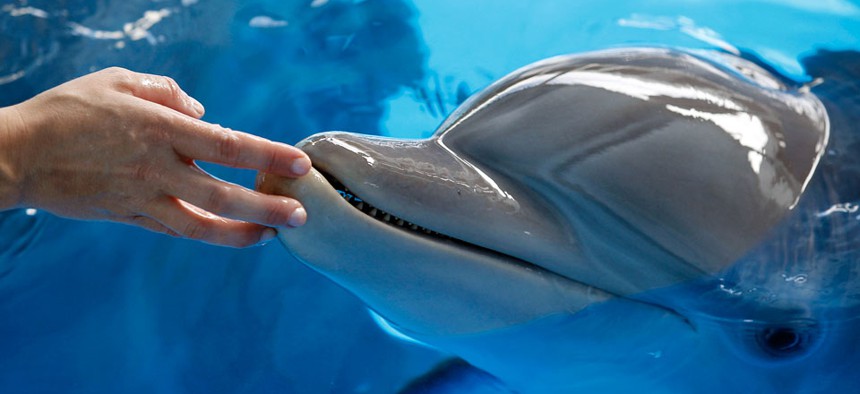Is Google's Secretive Research Lab Working on Human-Dolphin Communication?

Clearwater Marine Aquarium trainer Cindy Farber reaches out to touch Winter the dolphin on the nose in Clearwater, Fla. Chris O'Meara/AP
The short answer is 'no,' but the long answer is much more interesting.
It started innocently enough, as rumors do: A friend of a friend and I were chatting about Google and he said that his buddy said that Google's secretive research lab, Google X, was working on communicating with dolphins.
Whoa!
Interspecies communication is one of my all-time favorite topics. Some true Bay Area heroes like the 1960s collective, Ant Farm , got me into it. It's one of the few things that could be called "groovy" that is not terrible.
The old-timers took the task seriously, too. A guy named Doug Michels lobbied for years to create a dolphin embassy , so that we could start communicating more frequently with sea mammals. His efforts yielded an Esquire magazine article, a show at SFMOMA, and a Rockefeller Foundation grant.
But the embassy never got built. As Michels told an interviewer much later , "It became clear that it was a gigantic project beyond the scale we could accomplish with the funds we had raised."
Michels also advocated building a water-filled, orbiting space station that would house "a Supercomputer and a Population of Dolphins."
That was never built, either.

Nowadays, stories surface about trained dolphins or dolphins seemingly trying to communicate with humans .
But by and large, the last couple decades have not been a great time for mainstream interest in saying hello to cetaceans.
And so, when I heard about this Google X-dolphin thing, I was skeptical. Not because I didn't think people at Google would be interested; on the contrary, dolphins' clicks and squeaks seem like a perfect data set on which they could run some of their "deep learning" algorithms .
Learning to communicate with dolphins could be seen as practice for any sort of communication with extraterrestrials , which I'm sure some Google people imagine will happen in their lifetimes (because the Singularity will come and they will be immortal and their uploaded minds can travel on spaceships to Alpha Centauri).
So I filed it away for a while. Until I was reading through Burkhard Bilger's New Yorker feature on the driverless car , which was developed at Google X, and what do I see? A reference to CYBERNETIC DOLPHINS.

Next thing I know, I've discovered that a site belonging to Google's head of engineering, Ray Kurzweil, has linked to a scientific paper on a "' dolphin speaker’ to enhance study of dolphin vocalizations and acoustics ."
And you know, maybe delphic civilization had a little zazzle back! Dolphin researcher Denise Herzing gave a TED talk this year on dolphin communication, and it's received more than half a million views.
In any case, I was beginning to break out into an excited sweat. The narrative was all there: a broad, nerdy interest in dolphin codes gets distilled when some leaders of Google X see this TED talk.
And maybe Google X wasn't just decoding the dolphin speech. Maybe they were also playing it back to the animals. Maybe they really were working on this stuff!
In a very real sense, this would be the fulfillment of Michels' dream to put "a Supercomputer and a Population of Dolphins" in the same place. (Of course, for Michels that place was low-earth orbit, but close enough!)
I dashed off an email to Google X's press person, hoping, praying she'd say that the company was, in fact, solving interspecies communication. (That's solutionism I can get behind!)
Her initial response was discouraging: "I haven't seen any dolphin tanks out back anywhere."
But then ...
The real truth turned out to be a little more complicated. It's not that Google X is doing work on dolphin communication. BUT! BUT! BUT!
One of its close affiliates, wearable computing pioneer Thad Starner, who is a Technical Lead/Manager on Project Glass, is also working with dolphins .
Let's say that again: Starner, a Project Glass manager, is also working on human-dolphin communication in his academic role at Georgia Tech.
As a matter of fact, he's working with Denise Herzing, the TED talker, on something called the Cetacean Hearing and Telemetry project , which would allow for *real-time* communication with free-swimming dolphins. This is a major difference from most would-be communication systems, which have relied on captive dolphins and large, clunky apparatuses.
Herzing and her colleagues have been working for more than 15 years to associate certain sounds—outside the dolphins' normal vocabulary, but easy for them to mimic—with objects like seaweed, scarfs, and rope. Using that information, the Starner-Herzing system, which is still a prototype, is supposed to automatically translate when a dolphin uses the "word" for "rope" into the word "rope" for the diver in real-time.
"Instead of pushing a keyboard through the water, the diver is wearing the complete system and it's acoustic only. Basically the diver activates the sounds on a keypad on the forearm. The sounds go out through an underwater speaker. If a dolphin mimics the whistle or a human plays the whistle, the sounds come in and are localized through two hydrophones," Herzing explained at TED. "The computer can localize who requested the toy, if there is a word match. The real power of this is in the real-time sound recognition, so we can respond to the dolphins quickly and accurately."
All of which might be why the Google X engineer in Bilger's story, Anthony Levandowski, was talking about cybernetic dolphins .
Unless there are even more Googlers interested in such a good subject. I hope there are. And that, as soon as possible, they stop creating floating retail barges and whatever other crazy stuff, and start unraveling the mysteries of the undersea civilizations.
NEXT STORY: Sugar Daddy Dating Site Offers Obamacare Fix






